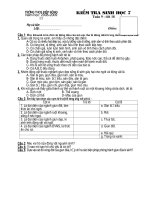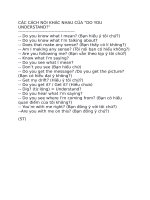Sự khác nhau giữa Who and whom
Bạn đang xem bản rút gọn của tài liệu. Xem và tải ngay bản đầy đủ của tài liệu tại đây (10.04 KB, 1 trang )
Who and whom
Whom
is the object form of the relative pronoun
who
. Both
who
and
whom
are only used to refer to people.
Students are often confused about
whom.
If you don’t know how exactly is
whom
used, don’t worry. In modern
English,
whom
is considered rather formal and old-fashioned. You might still come across this word in academic
and official writing. Nonetheless, it is something that you can totally eliminate from your writing.
‘Who’
is the modern equivalent that can be used in both formal and informal contexts.
For example consider the sentences given below.
You were speaking to a woman.
She is my boss.
Here the noun woman is the object of the preposition
to.
We can combine these two clauses using
whom
.
The woman
to whom
you were speaking is my boss.
Good to know
When a relative pronoun is used as the object of the verb, it will be immediately followed by another noun.
In the above example, the noun
you
follows the relative pronoun
whom.
In a less formal style, we can also write:
The woman
who
you were speaking to is my boss.
Note that the preposition now goes at the end of the clause ‘who you were speaking to’.
In an informal style, the relative pronoun
who
can be dropped and the sentence will still make sense.
The woman you were speaking to is my boss.
Be first to know when grammar rules change! Sign up to our newsletter here: englishgrammar.org (It's free)
Powered by TCPDF (www.tcpdf.org)









